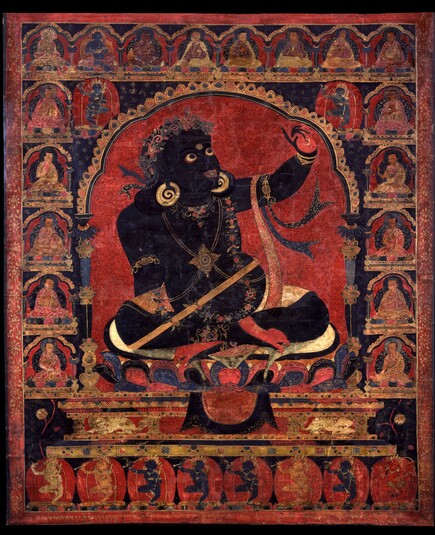
Item: Indian Adept (siddha) - Virupa
| Origin Location | Tibet |
|---|---|
| Date Range | 1400 - 1499 |
| Lineages | Sakya |
| Size | 36.20x31.75cm (14.25x12.50in) |
| Material | Ground Mineral Pigment on Cotton |
| Collection | Carolyn and Wesley Halpert |
Virupa, Yogeshwara (Tibetan: bir wa pa, nel jor wang chug. English: Ugly One, Lord of Yoga) foremost in magical attainments, from the famous group of 84 mahasiddhas of India, prominent lineage guru for the systems of Hevajra, Vajrayogini, Rakta Yamari, Rakta Jambhala and the like.
With a body dark brown in colour - burnt from exposure to the sun, corpulent and thick limbed, his face looks upward with large glaring eyes, the black pupils surrounded by white circles. The left hand is raised to the sky in a wrathful gesture with the index finger pointed in an accusatory manner, the palm red and marked with a golden Dharma wheel. Behind, the left hand placed on the moon disc seat supports the gently leaning torso. The crown of the head is adorned with various flowers and ribbons. Large circular bone earrings decorate the ears along with gold and jewel necklaces, bracelets and anklets. Hanging from the left arm is a red, blue and green scarf. A garland of flowers falls across the belly and a yellow meditation belt wraps from the left side around the right knee. A yellow loincloth is worn about the waist. In a relaxed posture with the legs loosely crossed, the soles of the feet red and marked with Dharma wheels, he sits atop a deerskin, moon disc and multi-coloured lotus blossom above an ornate lion supported jeweled throne. An elaborate backrest supported by vases, pillars and jewels ascends behind framing an ornate red filigree patterned backdrop.
Slightly above the central figure, at the left, is Hevajra in heruka form, blue, with one face and two hands. Holding a vajra upraised in the right and a skullcup to the heart with the left, a katvanga staff resting against the shoulder, he stands in a dancing posture on the right leg with the left drawn up. At the right side is the consort Vajra Nairatmya, blue, holding a curved knife aloft with the right hand a skullcup to the heart with the left, standing in a dancing posture on the left leg. The red flames of pristine awareness surround both.
At the top left is the primordial buddha Vajradhara, followed to the right by Nairatmya, Virupa, Sachen, Tsemo, Trakpa, Sakya Pandita, Tsog Gom Kunga Pal and the like.
At the bottom are 8 goddesses, starting at the left is (1) Vajra, white in colour, holding a curved knife in the right hand and a skullcup to the heart with the left, performing the activity of stambhanam. (2) Gauri: orange, holding a hook and a lasso, performs the activity of vashyam. (3) Variyogini: dark blue, holding a hammer and skullcup, ucchatanam. (4) Vajrayogini: dark blue, holding a vajra stick and skullcup, vidveshanam. (5) Nairatmya: black, holding a curved knife and skullcup, abhicharukam. (6) Khechari: orange, holding a hook and lasso, akarshanam. (7) Bhuchari: dark blue, holding a curved knife and skullcup, maranam. (8) Kurukulle: red, with one face and four hands holding a bow, arrow, hook and lasso. She performs the various activities of subjugation. All have a katvanga staff leaning against the left shoulder (except Kurukulle), standing on corpse, sun disc and lotus seats, surrounded by the flames of pristine awareness.
Jeff Watt 4-2000
Subject: Margapala Lineage Paintings (Sakya)
Collection of Caroline & Wesley Halpert
Indian Adept Main Page (Mahasiddha)
Painting Set: Lamdre Mahasiddhas
Indian Adept: Virupa (Left Pointing Gesture)
Indian Adept: Virupa Art History
Indian Adept: Virupa Main Page
Subject: Guruyoga Iconography Page
Subject: Lineage (Single Composition)
Subject: Margapala (Lineage All in One)
Subject: Ngor Tradition (Teachers)
Subject: Ngor Masterworks
Indian Adept: Virupa (Painting Masterworks)
Indian Adept: Siddha Appearance Masterworks (Painting)
Indian Adept: Virupa (Paintings)
Subject: Lineage Paintings - Linear
Subject: Lineage of Teachers Definition Page
Collection: Christie's, Painting (March, 2004; NY)
Indian Adept (Mahasiddha): Painting (Middle Period 15th-16th)
Indian Adept: Virupa (Art Chronology)
Subject: Five Foremost Mahasiddhas (Sakya Tradition)
Subject: Conch Shell Earrings (Spiral Design)
